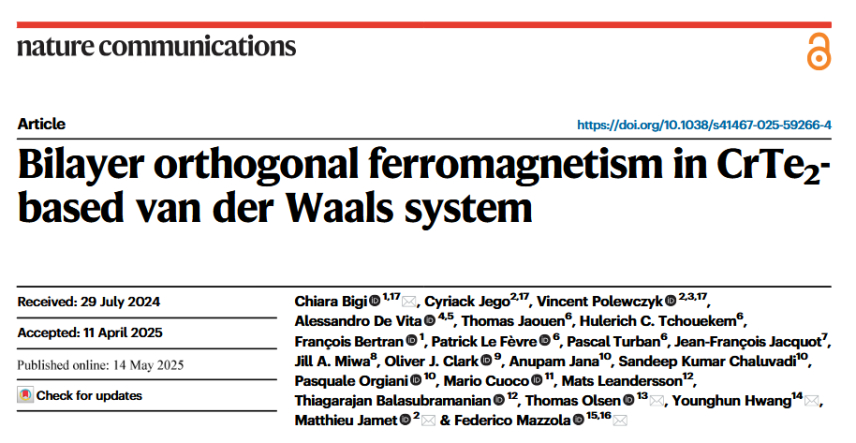An international team of researchers has discovered a new magnetic state of matter, termed orthogonal ferromagnetism. The results, led by Federico Mazzola (CNR-SPIN), were recently published in Nature Communications.
This state was identified in quasi-van der Waals compounds of the CrTe2 family, which are known for their layered geometries and strong spin anisotropy—key ingredients in the development of future spintronic and orbitronic technologies.Unlike previously known magnetic configurations, the orthogonal ferromagnetic phase features atomic layers in which the magnetization of adjacent regions points in maximally canted, mutually orthogonal directions—one in-plane and the other out-of-plane—within a single material block.This highly ordered but crossed arrangement does not rely on heterostructure stacking, making it unique and technologically appealing.
The discovery was made possible through the use of complementary advanced techniques, which revealed that, contrary to gradual spin reorientation transitions previously reported, this system exhibits abrupt spin-flop-like transitions under varying temperature and magnetic field. This sharply contrasting behavior underlines the existence of a distinct magnetic phase.
"In certain conditions, the material does not behave as expected," explains Federico Mazzola."Instead of gradually rotating its magnetic direction, it undergoes a sharp transition between two states.This happens across just two atomic layers, stabilized by an orthogonal magnetic ordering."
The implications of this discovery extend far beyond fundamental magnetism.The newly revealed orthogonal ferromagnetic phase offers a potential platform for spintronic devices that are faster, more compact, and energy-efficient.Devices built upon such abrupt, precisely controllable magnetic transitions could dramatically improve information processing, data storage, and sensor performance.
This finding adds to the growing understanding of exotic magnetism in low-dimensional systems and provides a promising route toward engineering devices where the electron's spin, rather than its charge, serves as the main carrier of information.The orthogonal alignment of magnetic states opens unexplored avenues for applications in next-generation electronics, including low-power memory, logic circuits, and spin-wave–based technologies.

Fig. Electronic structure of Cr1+δTe2.
The article "Bilayer orthogonal ferromagnetism in CrTe2-based van der Waals system" (Nat Commun 16, 4495. 2025) is available at: https://www.nature.com/articles/s41467-025-59266-4


